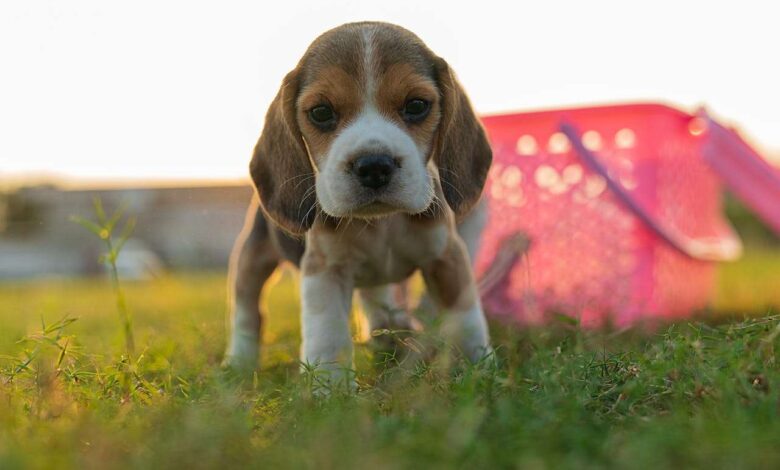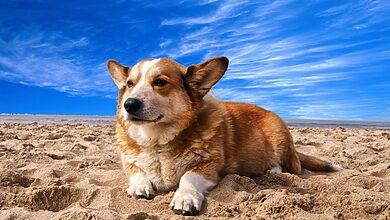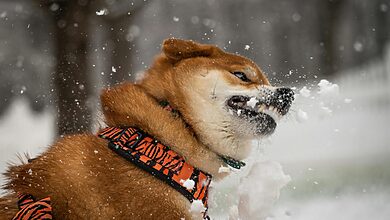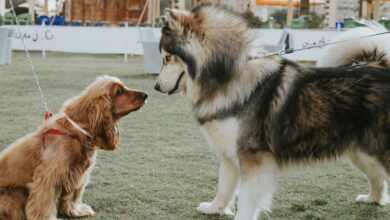Puppy Training 101: A Comprehensive Guide

Raising a puppy can be an incredibly rewarding experience, but it also comes with its own set of challenges. Proper training is essential for building a strong bond with your furry friend and ensuring a well-behaved companion.
In this guide, we’ll delve into the fundamentals of puppy training, providing practical tips and expert advice to help you raise a happy and obedient dog. From socialization and house training to basic obedience commands and crate training, we’ll cover everything you need to know to get started.
Let’s embark on this journey together and create a lifetime of memories with your new furry family member.
The Importance of Early Socialization
Early socialization is one of the most vital components of raising a well-adjusted dog. Proper socialization during the puppy stage can prevent many behavioral problems and foster a calm, confident, and friendly dog. The period between 3 and 14 weeks of age is often referred to as the “critical period” for socialization, where positive experiences can have a lasting impact on a puppy’s development.
What is Socialization?
Socialization involves exposing your puppy to various environments, people, animals, sounds, and experiences in a controlled and positive manner. The goal is to help your puppy learn how to behave in different situations and to reduce the likelihood of fear-based behaviors in the future.
The Benefits of Early Socialization
- Confidence Building: Puppies that are well-socialized are more likely to be confident and less fearful of new experiences.
- Prevention of Aggression: Socialization helps prevent aggressive behavior by teaching puppies to interact appropriately with other dogs and people.
- Adaptability: A well-socialized puppy is more adaptable to changes in their environment, making them easier to handle in various situations.
Steps to Socialize Your Puppy
- Start Early: Begin socializing your puppy as soon as you bring them home, but ensure that they are in a safe and controlled environment.
- Introduce New People: Allow your puppy to meet a variety of people, including children, adults, and elderly individuals. Ensure that all interactions are gentle and positive.
- Expose to Different Animals: Arrange playdates with other vaccinated puppies or calm adult dogs. This helps your puppy learn appropriate play behavior and reduces the likelihood of fear or aggression toward other animals.
- Vary Environments: Take your puppy to different locations such as parks, busy streets, and pet-friendly stores. Gradually increase the level of distraction to help your puppy become comfortable in various settings.
- Positive Reinforcement: Reward your puppy with treats, praise, or play whenever they successfully navigate a new experience. This reinforces positive associations with new situations.
Common Socialization Challenges
- Fear of New Experiences: Some puppies may be naturally more cautious or fearful. In such cases, it’s important to introduce new experiences slowly and at your puppy’s pace.
- Over-Stimulation: Puppies can become overwhelmed if introduced to too many new experiences at once. Keep sessions short and positive to avoid over-stimulation.
For more detailed information on early socialization, visit the American Kennel Club’s Socialization Guide.
House Training: A Step-by-Step Approach
House training is often one of the first challenges new puppy owners face. Successful house training requires patience, consistency, and positive reinforcement. With the right approach, your puppy will learn to eliminate outside or in a designated indoor area, keeping your home clean and your puppy stress-free.
Understanding House Training
House training involves teaching your puppy where it is appropriate to eliminate. Puppies have small bladders and need frequent potty breaks, especially during the first few months. Understanding your puppy’s natural schedule and setting up a routine will make house training smoother.
Step 1: Establish a Routine
- Regular Feeding Schedule: Feed your puppy at the same times each day. A consistent feeding schedule leads to a more predictable potty schedule.
- Frequent Potty Breaks: Take your puppy outside first thing in the morning, after meals, after playtime, and before bedtime. Puppies generally need to eliminate every 30 minutes to 1 hour, depending on their age.
- Choose a Designated Potty Spot: Take your puppy to the same spot outside each time for potty breaks. The familiar scent will encourage them to eliminate in the same area.
Step 2: Supervise and Confine
- Close Supervision: Watch your puppy closely for signs that they need to eliminate, such as sniffing the ground, circling, or whining. Take them outside immediately if you notice these behaviors.
- Use a Crate: When you can’t supervise your puppy, use a crate to prevent accidents. The crate should be just large enough for your puppy to stand, turn around, and lie down comfortably. Puppies are less likely to eliminate in a confined space where they sleep.
Step 3: Positive Reinforcement
- Praise and Rewards: Immediately praise and reward your puppy with a treat or playtime after they eliminate in the appropriate spot. This reinforces the behavior and makes them more likely to repeat it.
- Avoid Punishment: If your puppy has an accident indoors, clean it up without scolding them. Punishment can cause fear and anxiety, which may lead to more accidents. Instead, focus on reinforcing the desired behavior.
Step 4: Handle Accidents Properly
- Clean Up Thoroughly: Use an enzyme-based cleaner to remove any traces of urine or feces from indoor accidents. This will help eliminate any lingering odor that might attract your puppy to eliminate in the same spot again.
- Stay Calm: Accidents are a normal part of the house training process. Stay patient and consistent with your routine.
Common House Training Challenges
- Regression: It’s common for puppies to experience a brief regression in house training around 4 to 6 months of age. Stick to your routine, and your puppy will get back on track.
- Submissive Urination: Some puppies may urinate when they are excited or nervous. This usually improves with time and confidence-building exercises.
For a more detailed guide on house training, refer to The Humane Society’s House Training Tips.
Leash Training: Teaching Your Puppy to Walk Nicely
Leash training is an essential part of puppy training, ensuring that walks are enjoyable and safe for both you and your dog. A well-trained puppy will walk beside you without pulling, lagging behind, or getting distracted by every new sight and sound.
The Importance of Leash Training
Leash training not only makes walks more pleasant but also provides your puppy with essential exercise and mental stimulation. It’s an opportunity for your puppy to explore the world while learning to behave appropriately in public.
Step 1: Getting Started Indoors
- Introduce the Collar and Leash: Start by letting your puppy wear the collar indoors for short periods to get used to the feeling. Once they are comfortable, attach the leash and let them drag it around the house under supervision.
- Practice Indoors: Begin practicing leash walking in a distraction-free environment like your living room or hallway. Use treats to encourage your puppy to walk beside you. If they pull on the leash, stop walking and wait for them to return to your side before continuing.
Step 2: Transition to Outdoor Walks
- Start with Short Walks: Begin with short walks in a quiet area with minimal distractions. Gradually increase the distance and duration as your puppy becomes more confident and accustomed to walking on a leash.
- Teach Loose Leash Walking: To teach your puppy to walk on a loose leash, keep the leash short but relaxed. If your puppy starts to pull, stop walking and wait until the leash is slack again before proceeding. Reward your puppy when they walk nicely beside you.
Step 3: Dealing with Distractions
- Use High-Value Treats: When walking in a more stimulating environment, use high-value treats to keep your puppy’s attention. Reward them frequently for staying by your side and not pulling toward distractions.
- Gradual Exposure: Gradually expose your puppy to different environments, such as busy streets or parks, to help them learn to focus on you despite distractions.
Common Leash Training Challenges
- Pulling on the Leash: Puppies often pull on the leash out of excitement or curiosity. Consistently stop walking whenever your puppy pulls, teaching them that pulling will not get them where they want to go.
- Fear of the Leash: Some puppies may be initially fearful of the leash. In such cases, take it slow and allow your puppy to investigate the leash at their own pace, rewarding them for positive interactions.
For more leash training tips, check out The Spruce Pets’ Guide to Leash Training a Puppy.
Basic Obedience Commands: Sit, Stay, Come
Teaching your puppy basic obedience commands is essential for their safety and your peace of mind. Commands like “sit,” “stay,” and “come” are the foundation of a well-behaved dog and can be taught using positive reinforcement techniques.
The Benefits of Basic Obedience Training
Basic obedience commands help keep your puppy safe in various situations and make it easier to manage their behavior. Additionally, training sessions provide mental stimulation for your puppy and strengthen your bond.
Command 1: Sit
- How to Teach “Sit”: Hold a treat close to your puppy’s nose and slowly move it over their head. As they follow the treat with their eyes, their bottom will naturally lower into a sitting position. Once they sit, immediately praise them and give them the treat.
- Practice and Reinforcement: Practice the “sit” command multiple times a day in short sessions. Once your puppy reliably sits on command, begin practicing in different locations with varying levels of distraction.
Command 2: Stay
- How to Teach “Stay”: Start with your puppy in the “sit” position. Hold your hand out in front of you like a stop sign and say “stay.” Take a step back, and if your puppy stays in place, reward them with a treat and praise. Gradually increase the distance and duration of the “stay” command.
- Practice and Reinforcement: Practice in different environments and with increasing levels of distraction. If your puppy breaks the “stay,” calmly return them to the original position and try again.
Command 3: Come
- How to Teach “Come”: Start by attaching a long leash to your puppy’s collar. Allow them to explore a bit, then call their name followed by “come” in an excited tone. Gently tug on the leash if necessary to encourage them to come to you. When they reach you, reward them with a treat and lots of praise.
- Practice and Reinforcement: Practice the “come” command in various settings and gradually increase the distance. Always make coming to you a positive experience, even if your puppy was engaged in something fun.
Common Obedience Training Challenges
- Inconsistent Response: Puppies may not always respond to commands, especially in distracting environments. Continue practicing and gradually increase the difficulty by adding distractions.
- Lack of Focus: Puppies have short attention spans, so keep training sessions brief and engaging. Use high-value treats and enthusiastic praise to maintain their focus.
For more information on teaching basic obedience commands, visit Petfinder’s Puppy Training Tips.
Crate Training: A Safe and Secure Space
Crate training is an effective tool for house training and provides your puppy with a safe and secure space of their own. When done correctly, crate training can help prevent destructive behavior, ease anxiety, and create a positive environment for your puppy.
The Benefits of Crate Training
- Safety: A crate provides a safe space for your puppy when you’re unable to supervise them. It helps prevent accidents and keeps your puppy out of trouble.
- House Training: Crate training accelerates house training by encouraging your puppy to hold their bladder, as they are less likely to eliminate in a space where they sleep.
- Travel: A crate-trained puppy will feel more comfortable and secure during travel, whether by car or plane.
Choosing the Right Crate
- Size: Choose a crate that is large enough for your puppy to stand, turn around, and lie down comfortably. However, avoid crates that are too large, as they may encourage your puppy to eliminate in one corner and sleep in another.
- Type: Crates come in various materials, including plastic, metal, and fabric. Choose a crate that suits your needs and your puppy’s preferences. For example, plastic crates provide more privacy, while metal crates offer better ventilation.
How to Crate Train Your Puppy
- Introduce the Crate: Place the crate in a quiet area of your home and leave the door open. Allow your puppy to explore the crate at their own pace, using treats and toys to create positive associations.
- Make the Crate Comfortable: Line the crate with a soft blanket or bed to make it inviting. Place a few of your puppy’s favorite toys inside.
- Short Crate Sessions: Start by encouraging your puppy to enter the crate voluntarily. Close the door for a few minutes while you’re nearby, then gradually increase the duration as your puppy becomes more comfortable.
- Use the Crate for Naps: Encourage your puppy to nap in the crate during the day. This helps them associate the crate with relaxation and comfort.
- Crating at Night: Place the crate in your bedroom at night so your puppy can be close to you. This helps reduce anxiety and makes nighttime crating more comfortable.
Common Crate Training Challenges
- Crying in the Crate: It’s common for puppies to cry when first introduced to the crate. Avoid letting them out while they’re crying, as this can reinforce the behavior. Instead, wait until they’re quiet, then open the crate and reward them with praise.
- Resistance to the Crate: Some puppies may be hesitant to enter the crate. In such cases, try feeding your puppy their meals inside the crate or placing high-value treats near the entrance to entice them.
For more detailed crate training instructions, check out The ASPCA’s Guide to Crate Training.
Dealing with Puppy Biting and Chewing
Puppy biting and chewing are natural behaviors but can become problematic if not addressed early on. Understanding why puppies bite and chew and implementing appropriate training techniques will help you manage these behaviors effectively.
Why Puppies Bite and Chew
- Teething: Puppies go through a teething phase, usually between 3 and 6 months of age, during which they chew to relieve discomfort.
- Exploration: Puppies explore the world with their mouths, which often leads to biting and chewing.
- Play: Biting is a natural part of play for puppies, especially when interacting with their littermates.
How to Manage Biting
- Redirect to Toys: When your puppy bites, redirect their attention to a chew toy or bone. This teaches them what is appropriate to bite and chew.
- Use Positive Reinforcement: Praise your puppy and offer treats when they chew on appropriate items rather than on your hands or furniture.
- Teach Bite Inhibition: If your puppy bites during play, let out a high-pitched yelp and immediately stop the play session. This mimics how puppies interact with their littermates and teaches them that biting too hard ends the fun.
How to Manage Chewing
- Puppy-Proof Your Home: Remove or secure items that your puppy might be tempted to chew on, such as shoes, electrical cords, and remote controls.
- Provide Chew Toys: Offer a variety of chew toys that are safe and durable. Rotate the toys regularly to keep your puppy interested.
- Supervise and Confine: When you can’t supervise your puppy, confine them to a crate or puppy-proofed area to prevent destructive chewing.
Common Biting and Chewing Challenges
- Persistent Biting: If your puppy continues to bite despite redirection, try using a taste deterrent spray on your hands or clothing. These sprays have a bitter taste that discourages biting.
- Separation Anxiety: Puppies that chew excessively when left alone may be experiencing separation anxiety. In such cases, gradually acclimate your puppy to being alone for short periods and provide comforting items like a piece of your clothing in the crate.
For additional resources on managing biting and chewing, visit The Humane Society’s Guide to Puppy Biting and Chewing.
Puppy Proofing Your Home
Puppy-proofing your home is a crucial step in ensuring your new furry friend’s safety and preventing damage to your belongings. Puppies are naturally curious and will explore their environment with their mouths and paws, making it essential to create a safe space for them.
Room-by-Room Guide to Puppy Proofing
- Living Room: Secure electrical cords with cord protectors or tape them to the baseboards. Remove small objects that could be swallowed, such as coins, remote controls, and decorative items. Keep plants out of reach, as some houseplants are toxic to dogs.
- Kitchen: Use childproof locks on lower cabinets to prevent your puppy from accessing cleaning supplies, food, and other potentially harmful items. Keep trash cans secured or use a pet-proof trash can to prevent your puppy from rummaging through the garbage.
- Bathroom: Store medications, toiletries, and cleaning products in high cabinets. Keep the toilet lid closed to prevent your puppy from drinking toilet water or falling in.
- Bedroom: Keep laundry, shoes, and other personal items off the floor and out of your puppy’s reach. Secure any electrical cords and keep jewelry and small objects in closed drawers.
- Outdoor Areas: Ensure your yard is securely fenced and free of hazards like sharp tools, toxic plants, and standing water. Store chemicals like fertilizers and pesticides in a locked shed or garage.
Creating a Safe Space
- Designate a Puppy Area: Set up a specific area in your home where your puppy can play and rest safely. Use baby gates to section off this area if necessary.
- Provide Entertainment: Keep your puppy mentally stimulated by providing plenty of toys, chew bones, and interactive games. This will help prevent boredom and reduce the likelihood of destructive behavior.
- Regular Inspection: Regularly inspect your home for any new hazards that may arise as your puppy grows and becomes more adventurous.
For more tips on puppy-proofing your home, visit The American Kennel Club’s Guide to Puppy Proofing.
Positive Reinforcement Training: The Key to Success
Positive reinforcement is one of the most effective and humane methods for training your puppy. This approach focuses on rewarding desired behaviors rather than punishing unwanted ones, fostering a trusting and loving relationship between you and your puppy.
What is Positive Reinforcement?
Positive reinforcement involves rewarding your puppy immediately after they perform a desired behavior. The reward can be in the form of treats, praise, toys, or playtime. This encourages your puppy to repeat the behavior in the future.
Benefits of Positive Reinforcement
- Builds Trust: Positive reinforcement builds a strong bond of trust between you and your puppy, as they associate training with positive experiences.
- Encourages Learning: Puppies are more eager to learn when training sessions are enjoyable and rewarding.
- Reduces Fear and Anxiety: Unlike punishment-based methods, positive reinforcement does not create fear or anxiety in your puppy. Instead, it promotes a confident and well-adjusted dog.
How to Use Positive Reinforcement
- Timing is Key: Reward your puppy immediately after they perform the desired behavior to reinforce the connection between the behavior and the reward.
- Be Consistent: Consistency is crucial in positive reinforcement training. Ensure that everyone in your household is using the same commands and rewarding the same behaviors.
- Use High-Value Rewards: Find out what motivates your puppy the most, whether it’s a particular treat, a favorite toy, or enthusiastic praise. Use these high-value rewards during training sessions to keep your puppy engaged.
Common Positive Reinforcement Challenges
- Overfeeding: Be mindful of the number of treats you give during training sessions to avoid overfeeding. Use small, low-calorie treats, or substitute treats with praise or playtime when appropriate.
- Timing of Rewards: If you reward your puppy too late, they may not associate the reward with the correct behavior. Practice delivering rewards quickly and consistently.
For more information on positive reinforcement, visit The American Veterinary Society of Animal Behavior’s Guide to Positive Reinforcement.
Consistency is Key: The Importance of Routine
Consistency is one of the most important factors in successful puppy training. Establishing and maintaining a routine helps your puppy understand what is expected of them and reduces confusion, making training more effective.
Why Consistency Matters
- Predictable Outcomes: Puppies thrive on routine and predictability. Consistent training, feeding, and potty schedules help them learn faster and feel more secure.
- Reinforces Learning: Consistent commands, rewards, and corrections reinforce learning and make it easier for your puppy to understand what behaviors are acceptable.
- Reduces Stress: A consistent routine reduces stress and anxiety in puppies, as they know what to expect in their daily lives.
How to Maintain Consistency
- Set a Schedule: Create a daily schedule for feeding, potty breaks, playtime, and training sessions. Stick to this schedule as closely as possible.
- Use the Same Commands: Ensure that everyone in your household uses the same commands for the same behaviors. This prevents confusion and helps your puppy learn faster.
- Be Patient: Consistency takes time and patience. Stick with your routine, and remember that puppies are still learning and may make mistakes along the way.
Common Consistency Challenges
- Inconsistent Commands: If different family members use different commands for the same behavior, your puppy may become confused. Hold a family meeting to agree on the commands everyone will use.
- Irregular Schedule: Life can be unpredictable, and sticking to a strict schedule may not always be possible. When changes occur, try to maintain as much of your routine as possible and gradually adjust your puppy to any new schedules.
For tips on creating a consistent routine for your puppy, check out Cesar’s Way Guide to Puppy Routines.
Hiring a Professional Trainer: When to Seek Help
While many puppy training tasks can be handled at home, there are times when seeking the help of a professional trainer is beneficial. A professional can provide expert guidance, address specific behavioral issues, and offer advanced training techniques.
When to Consider a Professional Trainer
- Behavioral Issues: If your puppy is exhibiting problematic behaviors such as excessive barking, aggression, or severe separation anxiety, a professional trainer can help address these issues before they become ingrained habits.
- Advanced Training: If you want to teach your puppy advanced obedience commands, tricks, or specialized training such as agility or therapy dog certification, a professional trainer can provide the necessary expertise.
- Lack of Progress: If you’re struggling to make progress with your puppy’s training despite consistent efforts, a professional trainer can assess the situation and offer personalized solutions.
Choosing the Right Trainer
- Experience and Credentials: Look for a trainer with experience in puppy training and certifications from reputable organizations such as the Association of Professional Dog Trainers (APDT) or the International Association of Canine Professionals (IACP).
- Training Methods: Ensure that the trainer uses positive reinforcement methods rather than punishment-based techniques. Positive reinforcement is more effective and humane, fostering a better relationship between you and your puppy.
- Personalized Approach: Choose a trainer who offers personalized training plans tailored to your puppy’s specific needs and temperament.
Common Challenges When Hiring a Trainer
- Cost: Professional training can be expensive, but it’s an investment in your puppy’s future behavior and your relationship with them. Consider the long-term benefits of professional guidance.
- Finding the Right Fit: Not all trainers are the same, and it’s important to find one who is a good fit for you and your puppy. Don’t hesitate to ask for references or observe a training session before committing.
For more information on finding a professional dog trainer, visit The Association of Professional Dog Trainers.
Puppy Training
Training a puppy is a rewarding yet challenging journey that requires patience, consistency, and love. By understanding your puppy’s needs, using positive reinforcement techniques, and establishing a solid routine, you can set the foundation for a well-behaved and happy dog. Whether you’re tackling house training, leash walking, or basic obedience, remember that every puppy learns at their own pace. Celebrate the small victories and stay committed to the process. If you ever feel overwhelmed, don’t hesitate to seek help from a professional trainer who can provide expert guidance and support.
Training is not just about teaching commands; it’s about building a lifelong bond with your furry friend. With dedication and a positive approach, you’ll raise a confident, well-mannered dog who will bring joy to your life for years to come.
For further reading and resources on puppy training, consider exploring the following websites:
- American Kennel Club
- The Humane Society of the United States
- The Association of Professional Dog Trainers
Frequently Asked Questions (FAQ) on Puppy Training
1. How long does it take to house train a puppy?
House training can take anywhere from a few weeks to several months, depending on your puppy’s age, breed, and individual personality. Consistency, patience, and positive reinforcement are key to successful house training. Here’s a general outline to help you:
- Establish a Routine: Puppies typically need to go out first thing in the morning, after meals, after naps, and before bedtime. Take your puppy to the same spot each time, so they associate the area with potty time.
- Supervise: Keep a close eye on your puppy, especially during the first few weeks. Use a crate when you can’t supervise, as it helps prevent accidents.
- Praise and Reward: Immediately praise and reward your puppy when they eliminate outside. Positive reinforcement encourages them to repeat the behavior.
- Manage Accidents: If your puppy has an accident indoors, clean it thoroughly to remove the scent. Avoid scolding, as it can create anxiety and slow down the training process.
For more tips on house training, visit Petfinder’s House Training Guide.
2. What should I do if my puppy keeps biting?
Puppy biting is a natural behavior, especially during teething. However, it’s important to teach your puppy what is and isn’t acceptable. Here’s how:
- Redirect: When your puppy bites, immediately redirect their attention to a chew toy. This teaches them that toys, not hands, are appropriate for biting.
- Use Positive Reinforcement: Reward your puppy when they chew on appropriate items. Praise them when they play gently.
- Teach Bite Inhibition: If your puppy bites too hard, let out a high-pitched yelp, mimicking how their littermates would react. Stop play for a few seconds to show them that biting ends the fun.
- Avoid Rough Play: Rough play can encourage biting. Stick to gentle games and avoid activities that might overstimulate your puppy.
For detailed guidance on managing puppy biting, visit The Humane Society’s Tips on Stopping Puppy Biting.
3. How can I prevent my puppy from chewing on everything?
Chewing is a natural behavior for puppies, especially when they’re teething. Here’s how to manage it:
- Puppy-Proof Your Home: Remove or secure items that your puppy might chew on, such as shoes, electrical cords, and furniture.
- Provide Chew Toys: Offer a variety of chew toys to keep your puppy entertained and satisfy their need to chew. Rotate toys to maintain their interest.
- Use Deterrents: Apply taste deterrents to items you want to protect from chewing. These sprays have a bitter taste that discourages your puppy from chewing on them.
- Supervise and Confine: When you can’t supervise your puppy, confine them to a safe area or crate to prevent destructive chewing.
For more tips on preventing destructive chewing, check out The ASPCA’s Guide to Managing Chewing.
4. When should I start leash training my puppy?
Leash training can begin as soon as your puppy arrives home, typically around 8 weeks of age. Early leash training sets the foundation for good walking behavior. Here’s how to get started:
- Introduce the Collar and Leash: Start by letting your puppy wear the collar and leash around the house to get used to the sensation. Use treats and praise to create positive associations.
- Practice Indoors: Begin leash training indoors or in a quiet, fenced area. Encourage your puppy to follow you by calling their name and offering treats.
- Teach Loose-Leash Walking: Keep the leash loose and encourage your puppy to walk beside you. Reward them for staying close and not pulling. If they start to pull, stop walking and wait until they return to your side before continuing.
For step-by-step instructions on leash training, visit The American Kennel Club’s Leash Training Guide.
5. How do I crate train my puppy without making them anxious?
Crate training is a valuable tool, but it’s important to introduce the crate gradually to avoid causing anxiety. Here’s a step-by-step approach:
- Make the Crate Inviting: Line the crate with a soft blanket and place a few toys inside. Leave the door open and allow your puppy to explore at their own pace.
- Start Slowly: Encourage your puppy to enter the crate voluntarily by placing treats inside. Close the door for a few minutes while you’re nearby, gradually increasing the duration.
- Use the Crate for Naps: Encourage your puppy to nap in the crate during the day. This helps them associate the crate with relaxation and comfort.
- Avoid Using the Crate as Punishment: Never use the crate as a form of punishment, as this can create negative associations. Instead, make the crate a positive, safe space for your puppy.
For more detailed crate training tips, visit The ASPCA’s Crate Training Guide.
6. What’s the best way to teach my puppy basic obedience commands?
Teaching basic obedience commands like “sit,” “stay,” and “come” is essential for your puppy’s safety and behavior. Here’s how to approach it:
- Use Positive Reinforcement: Reward your puppy immediately after they perform the desired behavior. Use treats, praise, or playtime as rewards.
- Keep Sessions Short: Puppies have short attention spans, so keep training sessions brief and fun. Aim for 5-10 minutes per session.
- Practice Consistently: Practice commands multiple times a day in different environments to reinforce learning.
- Start with Basic Commands: Begin with simple commands like “sit” and “stay,” and gradually move on to more complex ones as your puppy masters the basics.
For a detailed guide on teaching basic obedience commands, visit Petfinder’s Puppy Training Tips.
7. How can I socialize my puppy during the pandemic?
Socialization is crucial for your puppy’s development, but the COVID-19 pandemic has presented unique challenges. Here are some ways to safely socialize your puppy:
- Introduce New Sounds and Sights: Expose your puppy to different sounds, sights, and environments around your home, such as the vacuum cleaner, doorbell, and various textures.
- Arrange Safe Playdates: If possible, arrange playdates with vaccinated and well-behaved dogs in your backyard or a controlled environment.
- Use Online Resources: Enroll in virtual puppy training classes or use online videos to expose your puppy to different stimuli and practice socialization skills.
- Take Walks in New Areas: Walk your puppy in different neighborhoods to expose them to new sights, sounds, and smells while maintaining social distancing.
For more tips on socializing your puppy during the pandemic, visit The American Veterinary Medical Association’s Guide.
8. What should I do if my puppy is afraid of other dogs?
Fear of other dogs is a common issue, especially in puppies that haven’t been properly socialized. Here’s how to help your puppy overcome this fear:
- Take It Slow: Start by introducing your puppy to calm, friendly dogs in a controlled environment. Allow your puppy to observe from a distance before gradually moving closer.
- Use Positive Reinforcement: Reward your puppy with treats and praise when they remain calm around other dogs. This creates positive associations with the presence of other dogs.
- Avoid Forcing Interactions: Never force your puppy to interact with other dogs if they are showing signs of fear or anxiety. Allow them to approach at their own pace.
- Seek Professional Help: If your puppy’s fear persists or worsens, consider consulting a professional dog trainer or behaviorist for personalized advice and training.
For additional guidance on addressing fear of other dogs, visit The ASPCA’s Dog Behavior Resource.
9. How do I know if I need to hire a professional trainer?
While many training tasks can be handled at home, there are situations where a professional trainer can be invaluable. Here’s when to consider seeking professional help:
- Persistent Behavioral Issues: If your puppy is showing signs of aggression, excessive barking, or severe separation anxiety, a professional trainer can provide the expertise needed to address these issues.
- Lack of Progress: If you’re struggling to make progress despite consistent efforts, a trainer can assess the situation and offer personalized solutions.
- Advanced Training Goals: If you’re interested in advanced obedience, agility training, or therapy dog certification, a professional trainer can provide the specialized training required.
For tips on finding a reputable trainer, visit The Association of Professional Dog Trainers.
10. What’s the best way to handle accidents during house training?
Accidents are a normal part of house training, but it’s important to handle them correctly to avoid setbacks. Here’s how:
- Stay Calm: Avoid scolding or punishing your puppy for accidents, as this can create fear and anxiety. Instead, calmly clean up the mess and move on.
- Clean Thoroughly: Use an enzymatic cleaner to remove all traces of the accident. This eliminates odors that might attract your puppy to the same spot.
- Reevaluate Your Routine: If accidents are frequent, consider adjusting your puppy’s feeding and potty schedule. Take them out more frequently, especially after meals, naps, and playtime.
For more advice on managing house training accidents, visit The American Kennel Club’s House Training Tips.








